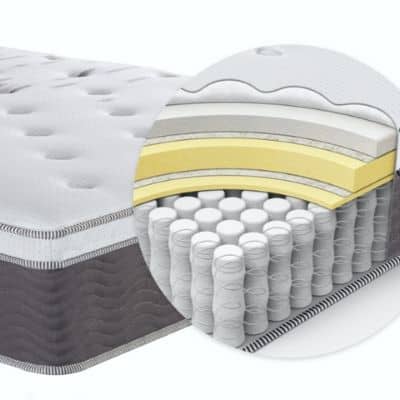
How should you sleep with a sprained ankle?
A sprained ankle is one of the most common injuries you may sustain, and sleeping with a sprained ankle can be uncomfortable and may affect the quality of your sleep.
If you find that your sleep is being affected as a result of your injury, then this article will hopefully provide some useful information on how to alleviate any discomfort and ensure you get a good night’s sleep. This guide will cover the following questions and topics;
- Should you sleep with a compression bandage?
- How to sleep with a sprained ankle
- Can walking on a sprained ankle make it worse?
Topics covered on this page
Should you sleep with a compression bandage?
If you have sprained your ankle or ankles, you may be advised to wear a compression wrap to help it heal quicker. However, you may be unsure whether or not you should wear it whilst you sleep.
The answer, to put it simply, is no – you should not sleep with a compression bandage, but why?
These bandages remove any fluid that builds up because of the ankle sprain and does so by compressing the sprained areas.
This compression forces excess fluid from the area, but while it does this, it also prevents any fluid coming into the area – reducing swelling.
However, although this compression is good to reduce swelling on the leg and ankle, wearing a compression bandage for too long can become detrimental to your ankle’s recovery. If you are struggling to see any improvement in the pain or swelling, and you find that an elastic bandage can help with the pain, you can wear one overnight if it is very loose.
Remember, the length of time that the compression bandage should be worn is entirely dependent on the severity of the injury, so act on the advice of a medical professional.
Make sure to observe any changes in the color of your skin, if you begin to feel numbness or notice a blue color, then the bandage is likely too tight and needs loosening.
So, when it is time to go to sleep, it is important that you remove the compression bandage to promote blood flow and recovery while you sleep.
Here is a short video on dealing with ankle sprains.
How to sleep with a sprained ankle
The most effective solution to healing ankle sprains is to allow plenty of time and rest to promote new cell growth and recovery in your ankle and leg. When sleeping at night it could help to ease your pain by sleeping on your side.
Ankle sprains are very common, and occur when the ligaments in the ankle become stretched, or torn beyond their usual range.

Ankle sprains are very common, and occur when the ligaments in the ankle become stretched, or torn beyond their usual range.
Depending on the severity of the ankle sprain, the amount of rest and recovery can vary, and this can range from 1-6 weeks for a full recovery.
It is important that during this time you ensure your ankle is sufficiently rested, and this means looking after your sprained ankle while sleeping.
So, what is the best position to sleep with a sprained ankle during the day or at night?
You may or may not be familiar with RICE, which stands for Rest, Ice, Compression and Elevation. This is a common treatment for any pain and swelling that may have been brought about by an ankle sprain or any other muscular injuries.
For a more detailed explanation of each treatment, read below:
Rest
You should rest and protect the injured muscle, in this case, your ankle. To properly rest, you should take a break from any activity that may be causing extra pain or soreness in the ankle sprain. It could be advisable to sleep on your side.
"Using ice can reduce any pain or swelling you may have as a result of your injury. You should apply an ice pack or a cold pack - a bag of frozen peas will do - to the ankle straight away, since this can help minimize further swelling to your ankle and foot."
BedroomZZ Tweet
Ice
Using ice can reduce any pain or swelling you may have as a result of your injury. You should apply an ice pack or a cold pack – a bag of frozen peas will do – to the ankle straight away, since this can help minimize further swelling to your ankle and foot.
A doctor would say that you should aim to do this for 10-20 minutes each time, 3 times a day.
If, after 2-3 days the pain or swelling has gone, then you can begin to apply some heat the area that is in pain, but make sure to never apply direct heat or ice to the skin as this can cause the skin to burn.
Compression
As stated previously, applying any form of compression to the ankle will help reduce pain and further swelling.
You should try not to wrap this too tightly as it can cause more swelling below the wrapped area, make sure to loosen the bandage if you feel it is too tight and is restricting blood flow to other parts of the body. Look out for numbness, tingling, more pain, coldness, or other swellings if the compression is too tight.
You should seek the advice of a medical professional if your symptoms do not improve for 2-3 days, as this could indicate a more serious problem.

Elevation
You should elevate and position the ankle while sleeping to alleviate any pain caused by your injuries.
The best way to do this is to lay on your back and put your feet on a pillow or two at the bottom of your bed. Keeping the ankle elevated on your pillow is one of the best ways to keep your ankle above the level of your heart, which promotes the reduction of selling as it reduces blood flow to the injured area.
Alongside RICE, you could take anti-inflammatory drugs such as ibuprofen or naproxen, as they can help reduce pain while your injuries are healing.
However, it is important to read and follow all instructions on the label. When the pain and swelling reduces, you can begin by stretching the muscles and following simple strengthening exercises, before gradually increasing this day by day to build up the ankle’s strength.
Can walking on a sprained ankle make it worse?
A sprained ankle is one of the most common injuries, and can occur when you least expect it, be it walking down the street or simply walking up some stairs. Because of this, you may think you can simply walk it off, and that the pain will subside soon enough.
However, it is more complex than this, and whether you can or cannot walk on a sprained ankle is dependent on the severity of the injury.
You see, ankle sprains come in 3 different grades, 1, 2 or 3, with 3 being the most severe form. So, although you may be tempted to walk it off at first, this can actually cause more damage to the sprained ankle and prolong your recovery time, meaning you will be in pain for even longer.
Therefore, it is important that you do not rush into walking on a sprained ankle, and it should be a gradual process of re-introducing weight on to it alongside strengthening and stretching exercises while following the RICE routine we have mentioned above.
If it is absolutely essential that you have to walk, then crutches, boots, or other support are a possible option to reduce the body-weight effect on the ankle.
This can improve the ankle’s strength without risking further injury later on. By taking your treatment seriously, including adequate rest and elevation while you sleeping in bed, then you are likely to speed up the recovery process.
If you rush back to strenuous activity then your injury and symptoms may worsen, so it is important that you follow the advice from your doctor closely.
Using physical therapy is possible to keep walking without injuring yourself any further.
You can have a look at many different physical therapy tips on a health website, and they can provide advice on the sort of therapy you may need.
For instance, your sprained ankle may have been caused by poor posture or balance, so by speaking to someone who has experience in dealing with these sorts of injuries, you can gain a better understanding of what may be causing the injury in the first place and what you can do to prevent them next time.
They will share many resources with you that provide the best advice on sleeping, moving around, how to keep your ankle elevated using pillows and for how many hours to do.
A physiotherapist or doctor will also devise a treatment program that will try to best your stability and balance to help you move around without putting too much stress on the ankle.
They will try and guide you through strengthening exercises without over-doing it and risking further injury.
They can also apply some manual therapy, which would include massages and stretches to increase the amount of blood flowing to the ankle, reducing swelling, and they may introduce you to a range of motion exercises to encourage ankle flexibility.
Final Thoughts
Hopefully, this article has underlined some key information to help you deal with a sprained ankle. Remember, by resting, applying ice, compression and keeping your ankle in an elevated position above your heart while you are sleeping are some of the best ways to treat your injuries.
In addition, although an ankle sprain is one of the most common injuries, it still needs treating properly to promote healing and prevent injury in the future.
Therefore, by wearing a compression, combined with stretching and strengthening exercises and a potential program devised by your physiotherapist, your ankle should heal properly and you will be back on your feet in no time.
Sleep help and guidance

How To Touch Someone In Their Sleep Without Waking Them Up
Unlike other senses, the touch sense does not turn off while you are asleep, instead, it remains active in case of an emergency which requires you to immediately wake up.

How Should You Sleep With A Sprained Ankle?
A sprained ankle is one of the most common injuries you may sustain, and sleeping with a sprained ankle can be uncomfortable and may affect the quality of your sleep.

How Do You Sleep After A Facelift?
A facelift is a cosmetic procedure that lifts up and pulls back the skin on the face to make it look smoother and tighter. This article gives you tips on how to get to sleep.

How Long Should You Sleep In A Recliner After Shoulder Surgery?
In order to aid in your recovery and healing, as well as to avoid any pain and discomfort in the future, you should aim to sleep in a recliner following your surgery.

How To Sleep With Headphones when in bed
You may find that sleeping with headphones helps for multiple reasons. This may be to cancel out any background noise outside or from a sleeping partner.

The Zinus Ultima Comfort Mattress
This type of mattress is intended to provide extra pressure relief and support. The mattresses are often infused green tea and charcoal, which really help you have a good night’s sleep..
